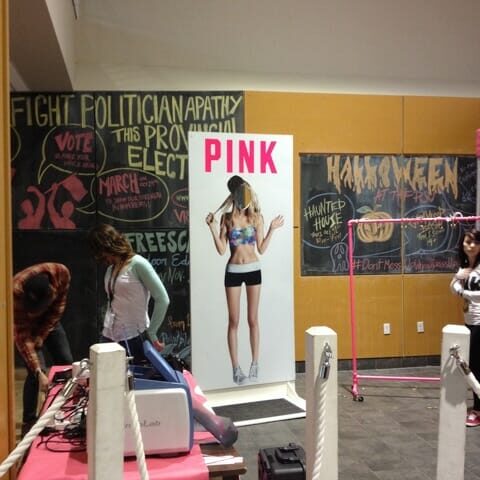
Earlier this month, a promotion for PINK, a sub-brand of Victoria’s Secret, took up the majority of the lobby of the Student Union Building. The promotion was part of the “PINK’s Got Spirit 2013 Campus Tour,” which has made its way across the country, stopping at major universities. Problematically, the primary feature of the promotion was a life size image of a Victoria’s Secret model with her face cut out.
She stood there, two-dimensional, in some not-too-scandalous lingerie and was, as you would perhaps suspect of a Victoria’s Secret model, young, white, blonde, and of course, skinny. Students wanting to enter for a chance to win prizes were asked to dress her in two-dimensional, cardboard, PINK-brand clothing, which could be Velcroed onto her body. They were then supposed to go behind the cutout, put their face in the hole where the model’s face should have been, and have their photo taken by the professional photographer that was working the promotion. In effect, each participant was supposed to pose as a PINK model.
I think we can all agree that clothing advertisements, especially those for lingerie, perpetuate unrealistic images of the female body. They also often rely on images that depict women as men would (apparently) like to see them. This isn’t new, and it’s certainly not unique to Victoria’s Secret. In fact, this sort of branding is, perhaps for obvious reasons, inherently part of the lingerie business. Lingerie is, after all, a lot about sex appeal.
As problematic as these unrealistic images may be, what’s more messed up it is the “PINK’s Got Spirit” campaign is taking this physically unrealistic and male-defined image of beauty (how many women really have that hip to waist ratio and legs that long?) and asking you to put your face in it.
We’ve all seen the “your face here” cutouts at popular tourist sites all over the world. Most often they consist of painted pirates, or fishermen, or jungle animals; always they are for the sake of dressing up, or playing pretend. The appeal of these cutouts is to allow individuals to put their face in an image or costume that they would never normally be able to appear in. The PINK campaign is not operating all that differently—in fact, it’s doing exactly the same thing. Across the country Victoria’s Secret is putting up an idealized image which for most women—depending on height and body composition—is impossible to achieve, and asking you to “play pretend” in it. (The organizers clearly recognized this because behind the cut out there were steps so participants would be tall enough to reach the hole.) Not only does this campaign directly promote an unrealistic image as ideal beauty, asking women to participate in the image overtly and explicitly perpetuates the sense that women should, and even must, strive to be like it in order to be beautiful.
It would be nice to think that this was a massive slip on the part of the campaign designers. Perhaps they were simply looking for a way to get students to participate in the promotion as opposed to just handing out freebies. Perhaps they didn’t realize the implications of turning a Victoria’s Secret model into a “your face here” photo-op. The truth is this is not the case; Victoria’s Secret knows exactly what message they are sending. The punning rhetoric of the campaign says it all. Right there on the PINK sign in the SUB, in small print under the campaign title: “sign up to get the skinny on events, offers and new campus gear.”







